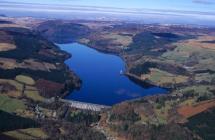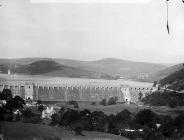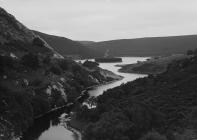Reservoirs of Wales
Items in this story:
Introduction
The origins of some reservoirs of Wales have had a contentious past that became linked with the Welsh Nationalist movement and arguments in favour of a government for Wales.
The controversy arose from the loss or displacement of Welsh speaking farming communities between 1880 and the 1960s, when valleys were flooded to provide drinking water to Liverpool and the Midlands. This has been well documented on the website: Abandoned Communities - Reservoirs of Wales
Lake Vyrnwy
During the late 1870s Liverpool Corporation recognised a need to improve their water supply and investigations commenced in the Vyrnwy Valley. Between the years of 1881 to 1888 a large masonry dam was built. This was the first dam to be constructed with a system of drainage tunnels incorporated to prevent the build-up of pressure beneath the base.
The dam is a gravity dam; this means that the Earth’s gravity holds the dam in place. It is constructed of a size and shape that mean it will not overturn, slide or crush at the toe. Vyrnwy Dam is built in a neo-Baroque architectural style and is topped with a carriageway of thirty-one arches. There are groups of four towers at either end of the central arch section, each capped with a pyramidal stone roof. The structure is 358 metres long and forty-four metres high, in 1888 is was the largest masonry dam in Britain.
Liverpool Corporation needed to purchase ten farms and the village of Llanwddyn to complete the scheme. The Ordnance Survey County Series mapping for Montgomeryshire from 1891 shows the original location of Llanwddyn village.It had a church and two chapels, three pubs, shops, a post office and about thirty-seven houses. The residents were moved to houses that still exist in the new village of Llanwddyn below the dam.
The site is now jointly managed by the Royal Society for the Protection of Birds (RSPB) and Severn Trent Water. It is designated as a National Nature Reserve, a Site of Special Scientific Interest, a Special Protection Area, and a Special Area of Conservation.
Elan Valley reservoirs
Birmingham Corporation needed drinking water for the Midlands and the Elan Valley Water Scheme was planned to the west of Rhayader.
At the time the Elan Valley had one hundred occupants who needed to be moved and only landowners received compensation. The scheme affected eighteen cottages and farmhouses, a school, a church and two manor houses. The nineteenth century poet, Percy Byshe Shelley had stayed in both Nantgwillt House and Cwm Elan House before they were submerged.
This was an ambitious civil engineering project and the construction phase lasted thirteen years from 1893 to 1906. The main features of the first phase of the scheme included the Caban Coch reservoir and dam, the Pen-y-Garreg reservoir and dam, and Craig Goch reservoir and dam. The Foel tower stands 52 metres above the Frankley Reservoir in Birmingham and the water is transferred through an aqueduct that is 117 kilometres long. Between the Garreg Ddu and Caban Coch reservoirs the Garreg Ddu dam is a submerged structure that has the appearance of a viaduct. It holds back water upstream so that it can be extracted at the Foel tower.
The work was substantially complete when the scheme was officially opened by King Edward VII and Queen Alexandra on 21 July 1904. The scheme is still supplying Birmingham's water. Between 1948 and 1952 the Claerwen dam was built to double the capacity of the original scheme to 345.5 million litres of water per day. The dam is 56 metres high and is supported on thirteen elliptical arches and it has stone parapets.
Since 1997 four Francis turbines and one Kaplan submersible hydropower turbine have been installed at the bases of all the dams and the Foel tower. The maximum energy output is 4.2 megawatts.
The Elan Estate is now owned by Dŵr Cymru / Welsh Water who are responsible for the Visitor Centre, the dams and reservoirs, the woodlands and most of the Elan Valley Trail. The Estate covers an area of 80 square kilometres that includes twelve Sites of Special Scientific Interest, and a National Nature Reserve.
Llyn Celyn
The most controversial of Welsh reservoirs was Llyn Celyn in the Tryweryn Valley. In 1955 Liverpool Corporation required a new reservoir for their water supply and they chose the Tryweryn Valley to the north of Bala.
The location affected the land of a traditional farming community. This was one of the last communities in Wales where people only spoke Welsh. The village of Capel Celyn, twelve farms, a school, a post office, and a chapel with its cemetery were all to be drowned by the proposed scheme, see (www.abandonedcommunities.co.uk). Some of the graves from the cemetery were moved to Llan-y-cil village, those that remained were covered in concrete.
Gwynfor Evans was the president of Plaid Cymru at the time and he was at the forefront of the protests. There was a major rally in Bala in September 1956 and in November there was a protest in Liverpool.
On 1 August 1957 the Liverpool Corporation Act was passed although there had been widespread opposition from ninety-five local authorities, from 210 churches, trade unions, and political and voluntary organisations, and from 375 individuals.
In the early 1960s the protests were directed against the dam itself during the construction phase. When the dam was officially opened 28 October 1965 there was a demonstration by members of the Free Wales Army. A political recognition that Wales needed to become a more independent country resulted from the protests.
During the 1950s and early sixties the words ‘Cofiwch Dryweryn’ (Remember Tryweryn) were often written in graffiti on walls and pylons. The name of Tryweryn, ’became an icon of national concern for the protection of rural Welsh life and the Welsh Language (www.cofiwchdryweryn.org.uk). At the side of the A487, as the road passes through Llanrhystud, the words are written on the gable end wall of a ruined house. It is one of the few surviving examples of protest graffiti from that era and it has been renewed and re-painted several times. In 2009 a fund was established to repair and protect the wall as a monument.
The reservoir is part of the Dee regulation system and water releases pass through a hydroelectricity plant with a maximum energy output of four megawatts. Downstream of the dam the River Tryweryn is used by the National White Water Centre during water releases, often enabling white water sports to take place during the summer.
Wildlife and Recreation
With the passage of time, when the abandoned communities have re-adjusted and the controversies have faded, the wildlife and recreation benefits of reservoirs become apparent. The uplands surrounding all of the reservoirs mentioned in this story are protected for their internationally important ecosystems and landscapes.
Surrounding Lake Vyrnwy there is the Berwyn Special Protection Area (SPA) and Site of Special Scientific Interest (SSSI). These protected areas also include the ‘Berwyn a Mynyddoedd de Clwyd’ Special Area of Conservation (SAC) and the Berwyn National Nature Reserve (NNR). This means that national and inter-national legislation protects the land from inappropriate development.
The site is now jointly managed by the Royal Society for the Protection of Birds (RSPB) and Severn Trent Water. Birds thrive on the dry heath, woodland, blanket bog and farmland habitats and there are bird hides, nature trails and a visitor’s centre with regular educational events.
The reservoirs of the Elan Valley Water Scheme fall within the ‘Elenydd-Mallaen’ Special Protection Area (SPA), within which there are other designations including the Elenydd SAC, the Claerwen NNR and twelve different SSSIs. The Elan Estate covers an area of eighty square kilometres and it is owned by Dŵr Cymru / Welsh Water who are responsible for the Visitor Centre, the dams and reservoirs, the woodlands and most of the Elan Valley Trail.
Llyn Celyn is located within the boundary of the Snowdonia National Park and the land immediately surrounding the reservoir has multiple forms of protection as the ‘Migneint-Arenig-Dduallt’ SPA, SAC and SSSI. The Ceunant Aberderfel SSSI is also close to the reservoir. Downstream of the dam the River Tryweryn is used by the National White Water Centre during water releases, often enabling white water sports to take place during the summer.
Lake Vyrnwy, the Elan Valley reservoirs and Llyn Celyn areas are now frequently visited by bird watchers, walkers, mountain bikers and others who appreciate the value of the upland environment. The Countryside and Rights of Way Act (CRoW) of 2005 opened up access to the mountain and moorland environments that surround the reservoirs. Future plans for reservoirs would be subject to more stringent environmental and planning legislation that has come into force since the 1990s.
Sources:
Wakelin,P & Griffiths, R.A (2008)’Hidden Histories, Discovering the Heritage of Wales’ RCAHMW
www.abandonedcommunities.co.uk , by Stephen Fisk
www.elanvalley.org.uk/dams-reservoirs
www.ccw.gov.uk
www.rspb.org.uk
www.elanvalley.org.uk/dams-reservoirs)
www.snowdoniaguide.com/llyn_celyn.htm
Claire Parry, RCAHMW, 2 November 2011.




